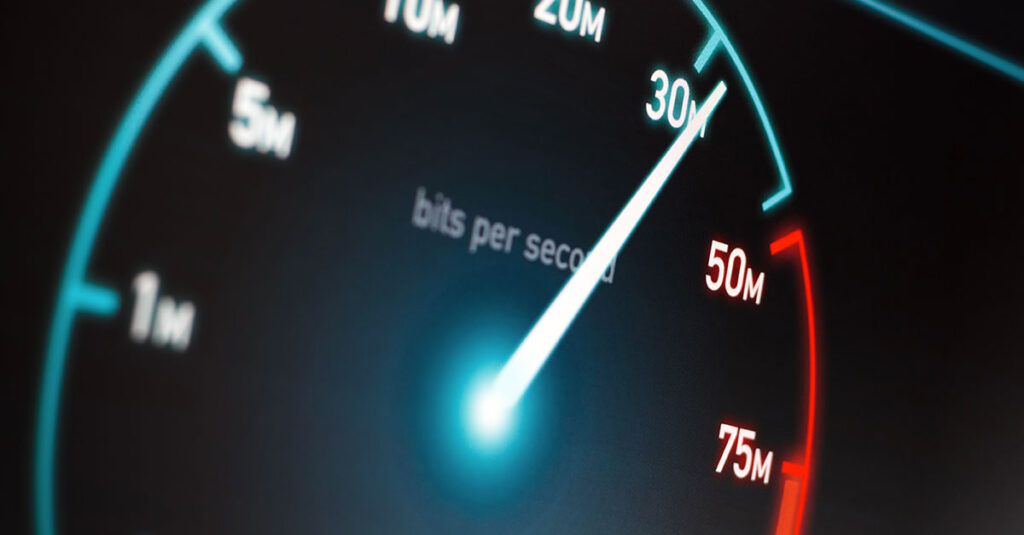
How Fast Is Internet Speed Going to Get?
2 commentsThe internet is increasingly central to modern life. We work, communicate, shop, play games, watch videos and even socialize online. If you’ve got a fiber optic connection right now, it probably feels really fast. But have you ever wondered just how much faster the internet could get?
What is internet speed?
The speed of your internet connection is basically how much data it can handle in a given second. It’s measured in Kilobits per second (Kbps), Megabits per second (Mbps) or Gigabits per second (Gbps)—depending on how fast it is.
For most connections, there are two components: download speed and upload speed. Download speed is how fast your connection can get things from the internet to your home. If you’re streaming movies on Netflix, saving attachments from your email or just browsing the web, you’re mostly relying on your download speeds. Upload speed, then, is how fast your connection can upload things from your computer to the internet. If you’re posting on Instagram, livestreaming yourself on Twitch, participating in Zoom calls for work or attending online classes, you’re uploading.
Because most home internet users download more than they upload, everything is configured so the download speed is faster. (The exception here is fiber connections, which can offer symmetrical speeds: things upload and download at the same fast rate.)
What are current internet speeds?
How fast your internet is depends on the kind of connection you have. Older technologies that rely on copper cables and telephone wires tend to have slower speeds than more modern technologies that rely on fiber optics.
- Dial-up connections were very slow. They had a maximum theoretical speed of just 56 Kbps. That’s 0.056 Mbps.
- A strong DSL connection might provide 30 Mbps download and 10 Mbps upload. Enough to watch Netflix and work online, but too slow for a large household.
- A good modern cable connection can offer around 300 Mbps download and up to 50 Mbps upload. Enough for a family, but you might still encounter some slowdown from time to time.
- Fiber is the best connection available right now. You can get both Gig fiber (which is 1 Gbps or 1,000 Mbps) and 2 Gig fiber (2 Gbps or 2,000 Mbps) in some areas of the country.
Currently, around 43% of U.S. households have access to fiber. Over the next few years, it will roll out to more and more households, giving consumers access to better technology and, thus, faster speeds. If you don’t have fiber yet, don’t worry—it’s coming.
How does internet speed get faster?
Fiber uses light to transmit data at incredibly high speeds. Right now, you can get Gig and 2 Gig fiber in many locations. That’s the fastest broadband most people are likely to have access to. Soon, though, you may be able to get 10 Gig internet. It’s already available in a few places and will roll out more widely over the next decade. That would offer 10 Gbps speeds both up and down!
How? Those fiber optic cables can transmit data even faster than they’re doing now. The technology around them and a few other bits of infrastructure will be upgraded, bending the light in different ways.
Why would we need faster internet speeds?
Streaming is and will probably continue to be one of the greatest demands on fiber speed. As video streaming with higher resolution—even at 16K—becomes available, the internet speed will have to keep up. Recently, researchers in Japan achieved data transmission rates through optical fiber of 319 terabits per second, over 1,000 times faster than 1 Gig speed. What’s more, working from home could be transformed, as this ultrafast fiber could send the contents of your entire hard drive in just seconds.
At this moment, our devices aren’t fast enough to demand this kind of speed. We do know, however, devices will continue to advance and we’ll probably integrate more and more of them into our lives. As these will be used concurrently in our homes, we’ll need to have this unrestrained internet speed. Having the fastest possible connection in both directions—uploading and downloading—means you’ll always be able to handle the traffic.
How fast will Wi-Fi get?
Wi-Fi is interesting because the limit isn’t related to your internet connection, but the devices that connect to it.
No matter how fast your internet speed, a Wi-Fi 4 router maxes out at 600 Mbps, a Wi-Fi 5 router at 3.5 Gbps and a Wi-Fi 6 router at 9.6 Gbps. And those are theoretical values for single connected devices—the real world values are a lot lower. If you have a Wi-Fi 6 router and compatible device, you’re more likely to see maximum speeds of around 1,200 Mbps. That’s faster than a Gig fiber connection, but it’s only going to get faster.
Wi-Fi 7 (802.11be), due to be released in 2024, will offer up to 46 Gbps. We can expect Wi-Fi 8 to be faster still.
How do I get the fastest speeds now?
Fiber is the future of high-speed internet—and the secret to getting the best internet speeds now. If you have access to one, a Gig or 2 Gig fiber connection is about the fastest internet available to home users.
And best of all, fiber is future-proof. As the infrastructure upgrades, those same cables will keep transmitting data into your home faster and faster. Be sure your router and devices are compatible with higher speeds so they can keep up.
Frontier Fiber is built for the way you live today—and tomorrow
If you’re still on the lookout for the right ultra fast internet connection for streaming, gaming, working from home and running your smart home—all with enough bandwidth for everyone, find out about Frontier Fiber. Then check here to see when it’s available at your address.




Hello. I just had a question about something. You know how inside of games, there are geographical server hosting, like a server located in – lets say in the UK. If a person from the USA plays on a server being hosted in the UK – the person in the US will get high ping. This is due to the longer data travel from US to UK. In the future is it possible to use the Fiber cable to reduce ping inside of games if a region is being hosted far away from you?
I like the way you think, Eugene! As a matter of fact, it’s completely in line with how the worldwide Internet we all depend on daily is built! The subsea / submarine cables that connect the continents and enable Internet connectivity around the world are fiber optic lines. In fact practically all spans of any significant distance, whether between continents and countries or even just your town to the next, is over fiber optic lines. Distance, unfortunately, still introduces some latency no matter the technology used to transmit the data. More recently, within the last couple of decades, bringing the benefits of fiber optic directly to the home has become a reality and that, coupled with increasing demands for both downstream and upload bandwidth is what drives us to continue pushing forward with building Gigabit America. ^Michael